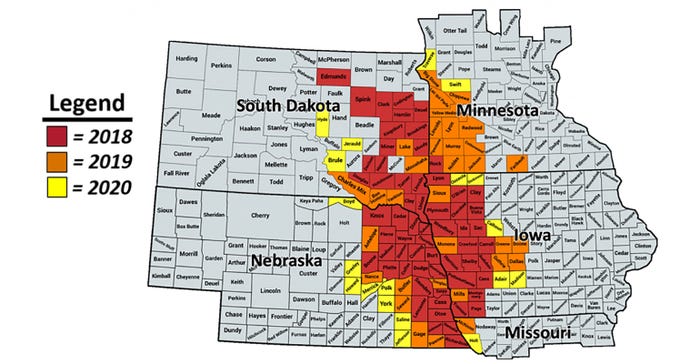June 28, 2021

Recently, the first adult soybean gall midges were collected in Iowa and Minnesota. The positive detections were located in Buena Vista County, Iowa, an area with persistent soybean gall midge populations since at least 2017.
The adults have been steadily emerging from Nebraska for over a month. Approximately two weeks after first emergence, plant injury was noted at some Nebraska collection sites. Based on the adults’ emergence timing, feeding injury is expected to start appearing near previously infested fields next week.
 Locations in Nebraska, Iowa, Minnesota, South Dakota and Missouri where soybean gall midge has been identified.
Locations in Nebraska, Iowa, Minnesota, South Dakota and Missouri where soybean gall midge has been identified.

Soybean gall midge is a new soybean pest that is only known to occur in 114 counties in five states (see map): Nebraska, Iowa, Minnesota, South Dakota and Missouri. Currently, 31 counties in western Iowa have positive detections as of 2020. The larvae (maggots) of gall midges feed inside the stem near the base of the soil. Eventually, infested plants may become brittle and break off at the site of feeding. Entire plants may die as a result of feeding, causing significant yield losses for a field. Typically, infestations begin at the field edge, where farmers will notice wilted or dead plants, and then advance toward the interior.
Soybean gall midge resources
Iowa has several trapping locations this year and supports a regional trapping network in four states. Iowa State University will continue to provide updates on adult emergence throughout the summer. To stay up to date on state and regional midge activity, growers are encouraged to subscribe to the Alert Network, soybeangallmidge.org/sign-up-for-network-updates.
Learn how to scout for soybean gall midge larvae in these videos, soybeangallmidge.org/scouting-for-soybean-gall-midge.
Thanks to Lauren Schwarck of Corteva Agriscience for monitoring several emergence traps this year.
Source: Iowa State University Integrated Crop Management News, which is responsible for the information provided and is wholly owned by the source. Informa Business Media and its subsidiaries aren't responsible for any of the content contained in this information asset.
You May Also Like




